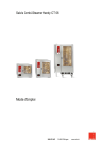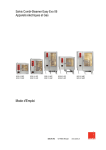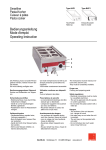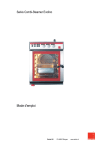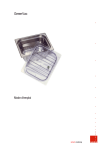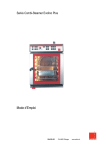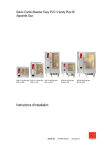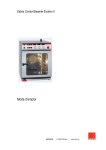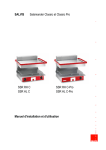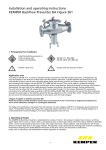Download Installation and Operating Instructions
Transcript
Smartline Gas cooking appliance Table-top unit AKG2 Built-in unit BKG2 Installation and Operating Instructions SALVIS AG Nordstrasse 15 CH-4665 Oftringen www.salvis.ch 2 / 13 Dear customer, Before you operate the gas cooking appliance, please read the Installation and Operating Instructions carefully. These instructions contain important information about proper installation and operation. Any documents supplied with the appliance should always be kept readily available and should be handed on with the appliance. Application For all cooking applications with cooking or frying utensils. Notes The appliance is manufactured according to the requirements of the relevant European standard (EN 203-1). The appliance is factory-set to high-calorific natural gas (type H). Entering the name plate information Before setting up the appliance please enter the name plate information below. Please provide this information when requesting a service or spare parts for the appliance. It will help us to respond to your query more quickly. Type: Year of manufacture: Appliance no.: 3 / 13 CONTENTS 1. Hints on operational safety.................................................................................................. 5 1.1 Daily operation ......................................................................................................... 5 1.2 Risk of injury ............................................................................................................ 5 1.3 Fire hazard............................................................................................................... 5 1.4 Risk of damage ........................................................................................................ 5 1.5 Connection, changeover, maintenance ................................................................... 5 1.6 Swiss regulations..................................................................................................... 6 2. Setting up, connection......................................................................................................... 7 2.1 Setting up................................................................................................................. 7 2.2 Gas connection ........................................................................................................ 7 3. Commissioning.................................................................................................................... 8 3.1 Establishing readiness for operation ....................................................................... 8 3.2 Igniting the pilot flame.............................................................................................. 8 3.3 Notes regarding operation ....................................................................................... 9 4. Switching off ........................................................................................................................ 9 5. Cleaning and maintenance ................................................................................................. 9 5.1 Daily cleaning......................................................................................................... 10 5.2 Weekly cleaning..................................................................................................... 10 6. Troubleshooting................................................................................................................. 10 7. Technical data ................................................................................................................... 11 7.1 Salvis gas cooking appliances............................................................................... 11 7.2 OEM gas cooking appliances ................................................................................ 11 8. Changeover to other gas type........................................................................................... 12 8.1 Nozzle table / overview.......................................................................................... 12 8.2 Replacing the external nozzle................................................................................ 13 8.3 Replacing the low nozzle ....................................................................................... 13 8.4 Replacing the pilot burner nozzle .......................................................................... 13 9. Maintenance...................................................................................................................... 13 10. Disposal............................................................................................................................. 13 Aarburg, 20 April 2007 Article no. BI 371'932 E 4 / 13 1. Hints on operational safety 1.1 Daily operation The appliance must only be operated - by trained staff, - under supervision, - for the purpose specified in the operating instructions. - Outdoors the appliance may only be operated under a cover and with adequate wind protection! Keep the appliance dry! - Do not use the appliance for storage purposes! - Do not use cookware that covers the whole surface! - Only use cookware suitable for gas cookers. - The appliance must not be used for deep-frying! - If a malfunction cannot be rectified by following the instructions in the troubleshooting section (section 5), close the gas control knob (position ), close the gas tap, and notify customer service. 1.2 Risk of injury Risk of burns! The upper part of housing and the sliding grate become hot during operation! Existing combustion air supply and exhaust gas installations must not be modified, e.g.: - Reducing the installation space; - Subsequent sealing of windows and doors; - Closing or removing the combustion air supply openings. 1.3 Fire hazard Do no place inflammable objects on the appliance! Fire extinguishers approved for cooking oil and fat fires must be made available. 1.4 Risk of damage Do no allow liquids to enter the burner or pilot burner! Risk of blocking the nozzles! Do not place any empty saucepans or frying pans on the hob when the appliance is switched on in order to prevent damaging your cookware or the glass ceramic hob. Do not place hot cookware on stainless steel tabletops or work surfaces in order to prevent permanent deformation. Do not hose down or clean the appliance with a water hose, high-pressure cleaner, steam highpressure cleaner or steam cleaner! After prolonged periods of non-use the functionality of the appliance should be checked as part of a service! 1.5 Connection, changeover, maintenance The appliance must be connected by an approved gas installer! In commercial kitchens work on gas equipment such as: - Changeover to other gas type - Inspection, maintenance - Repairs - Commissioning may only be carried out by: - the gas supply company; - a competent representative of the manufacturer; - an installation contractor; or a distribution agency authorised by a liquid gas supplier. 5 / 13 Before connecting the appliance: - notify the relevant gas supply company; - check that the gas type set at the appliance matches the gas on site; During inspection, connection, changeover or maintenance of the gas appliance check the: - exhaust gas route from the installation space; - fresh air supply to the combustion units; - leakproofness of the gas-carrying parts (leak spray); - fire safety and combustion quality; - ignition, safety and control equipment. The technical regulations for gas installation DVGW-TRGI Gas must be followed: G 600 (DVGW-TRGI 1986, G 628, G 634, G 660, and technical regulations for liquid gas TRF). The installations must be carried out according to the installation instructions of manufacturer and the generally accepted state of the art. Protect the gas supply line from overheating! Only original and suitable burner components must be used. Installation of other components and so-called gas economisers is prohibited. If the appliance is installed in conjunction with electrical appliances, the equipment must be included in an equipotential bonding system. The effectiveness must be verified according to VDE 0 190. 1.6 Swiss regulations The following regulations must be followed during setting up and installation: - SVGW gas regulations G1 - FCOS guideline no. 1942: liquid gas, part 2 (FCOS: Federal Coordination Commission for Occupational Safety) - regulations of the "Vereinigung Kantonaler Feuerversicherungen - VKF" (association of cantonal fire insurers) Safety clearances specified by t manufacturer between inflammable material (fire protection distance): The built-in unit may only be installed in a CNS cover. Table-top unit AKG2 Key for safety distance: - to rear panel - to side panel - to top surface - to cooker hood Built-in unit BKG2 SA/R SA/S SA/O SA/A 100 mm 200 mm 650 mm 650 mm 6 / 13 2. Setting up, connection During transport by hand: Be aware of the weight of the appliance and wear safety gloves! The relevant local regulations must be followed. The installations must be carried out according to the installation instructions of manufacturer and the generally accepted state of the art. Appliance installation and induction should be carried out by the customer service. Please follow the operational safety instructions, see section 1. 2.1 Setting up Set up the appliance: - horizontally and protected from vibration, - under an extraction hood, - not on heated or inflammable surfaces; - not at inflammable walls. Installation of individual appliances on narrow tables or frames: Secure the appliance and the table or frame against overturning, e.g. by screwing to the wall or floor. Remove the protective film from the appliance. Remove adhesive residues with solvent or benzine. 2.2 Gas connection Please follow the operational safety instructions, see section 1. Connecting the gas supply line: Installation in conjunction with electrical appliances: - Connect the appliance to the equipotential bonding system. After connection or changeover to a different gas type: - Check all gas-carrying parts for leaks (leak spray). Gas connection thread T1/2“ (external thread) 7 / 13 3. Commissioning The appliance must be connected properly to ensure proper operation. Setting up and connection see section 2. Before commissioning clean the appliance with a fat-dissolving cleaning agent. Dry cleaned parts and surfaces with a soft cloth. Cleaning see section 5. 3.1 Establishing readiness for operation Check the correct position of the burner and pilot burner covers. Sliding grate Place the sliding grate correctly. Burner cover Open the gas tap provided by the customer (main gas shut-off device). Pilot burner cover 3.2 Igniting the pilot flame Gas lighter After prolonged periods of non-use, e.g. if the (main shut-off device was closed, the pilot flame may take a little longer to ignite (the gas supply line first has to fill with gas). Push in and hold the gas control knob, and turn it to Gas control knob for Gas control knob for front burner rear burner the ignition symbol. Ignite the pilot flame with a gas lighter. Once the pilot flame has ignited, keep the gas control knob pressed for approx. 5-10, to allow the thermocouple to heat up, so that the gas supply is not interrupted again automatically (automatic safety pilot). Setting the burner flame After the ignition procedure release the gas control knob and set it to high. For switching between high and low flame push in the gas control and turn it to low. Low heating output, small flame symbol High heating output, large flame symbol 8 / 13 3.3 Notes regarding operation Any spillage or boiled over food residue should be removed from the gas cooker immediately! Caution - hot surfaces! The gas cooker is equipped with a thermoelectric safety pilot. If the pilot flame goes out the safety pilot automatically interrupts the gas supply, thereby preventing gas from escaping. The gas cooker is equipped with different burner output levels. This is apparent from the different sizes of the burner covers. Hobs 4. Operating panel for built-in module Switching off Push the gas control knob and turn to the Off position (symbol ). Close the gas tap provided by the customer gas tap (main shut-off device). Clean the appliance, see section 5 below, "Cleaning and maintenance". 5. Cleaning and maintenance Notes Avoid corrosive cleaning agents coming into contact with the operating panel and the rotary switches! Do not hose down or clean the unit with a water hose, high-pressure cleaner, steam highpressure cleaner or steam cleaner! Follow the instructions of the cleaning agent manufacturers! Do not use abrasive cleaning agents! Stainless steel must not come into prolonged contact with concentrated acids, vinegar essence, saline solution, mustard, spice mixtures, in order to avoid damage to the protective layer. Rinse stainless steel surfaces after use. Cleaning agents and care products Suitable cleaning agents and care products are available from customer service. These include: - Fat-dissolving cleaning agents or special stainless steel cleaners; - Stainless steel grill cleaner; - Stainless steel care products. Further information is available from your customer service agent. 9 / 13 5.1 Daily cleaning Push in the gas control knob, turn to Off position (symbol ) and close the gas tap provided by the customer gas tap (main shut-off device). Leave the gas cooker to cool down. Sliding grate Burner cover 5.2 - Remove the sliding grate and the burner covers and clean them with fat-dissolving cleaning agents in a basin. - Soak stubborn residues in the rinsing liquid. - Clean the housing with fat-dissolving cleaning agents or special stainless steel care products. - Remove any burnt food residue from stainless steel surfaces using grill cleaner. - After using grill cleaner or other strong cleaning agents, wash the cleaned parts thoroughly with water. - Dry cleaned parts and surfaces with a soft cloth. Weekly cleaning Pilot burner cover - Remove the pilot burner cover. - Remove any residues from the pilot burner and the thermocouple with a fine wire brush. - Do not use wet or damp cloths for cleaning! During cleaning ensure that the pilot burner and the nozzle are not dirty / clogged! - Insert the pilot burner cover. Pilot burner Thermocouple 6. Troubleshooting In the event of a fault with the gas cooker please refer to the following troubleshooting table: Fault Cause Remedy The pilot flame does not ignite. Gas tap/main shut-off device closed. Open gas tap/main shut-off device. Pilot burner dirty Clean pilot burner. The gas control knob was not pressed long enough. Keep the gas control knob pressed for approx. 5-10 seconds, in order to allow the thermocouple to heat up and prevent interruption of the gas supply. Thermocouple dirty Clean thermocouple. Thermocouple faulty. Notify customer service. The pilot flame goes out when the gas control knob is released. If troubleshooting fails: - Push the gas control knob in and turn to the Off position (symbol ), - Close the gas tap provided by the customer (main shut-off device, - Do not open the housing; - Notify customer service. 10 / 13 7. Technical data Technical data Gas cooker with 2 burners Gas appliance type A1 Rated heat load (total) 8.5 kW Connected load, liquid gas 0.66 kg/h Connected load, natural gas 0.9 m3/h Gas connection diameter T 1/2" (external thread) Cookers 1 x 3.5 kW; 1 x 5 kW Control range Large / small flame External dimensions (W x D x H) 400 x 600 x 295 mm Weight approx. 19 kg Subject to technical modifications! Gas categories Country CH CH DE Category II 2H 3B/P II 2H 3+ II 2ELL 30/P P (mbar) natural gas 20 20 20 P (mbar) liquid gas 50 28-30/37 50 Country GB BE NL Category II 2H 3+ II 2E+ 3+ II 2L 3B/P P (mbar) natural gas 20 20/25 25 P (mbar) liquid gas 28-30/37 28-30/37 30 Gas categories 7.1 Salvis gas cooking appliances Type Name Gas type mbar Item No. AKG 2 Table-top model Natural gas H* 20 mbar BI 371'922 BKG 2 Built-in model Natural gas H 20 mbar BI 371'923 AKG 2 Table-top model Liquid gas 28-30/37 mbar BI 371'924 BKG 2 Built-in model Liquid gas 28-30/37 mbar BI 371'925 AKG 2 Table-top model Liquid gas 50 mbar BI 371'926 BKG 2 Built-in model Liquid gas 50 mbar BI 371'927 AKG 2 Table-top model Natural gas L** 25 mbar BI 371'928 BKG 2 Built-in model Natural gas L 25 mbar BI 371'929 Product line extension with consideration of SVGW and DVGW test certificates possible. * H = high-calorific 7.2 ** L = low-calorofic OEM gas cooking appliances Type Name Gas type mbar Item No. AKG 2 Table-top model Natural gas H 20 mbar CE 371'922 BKG 2 Built-in model Natural gas H 20 mbar CE 371'926 11 / 13 8. Changeover to other gas type Please follow the operational safety instructions, see section 1. The gas cooker factory-set to natural gas H. Only use original nozzles for changeover to other gas types. After changeover to another gas type and after maintenance work check all gas-carrying parts for leaks (leak spray). Attach a sticker to the gas cooker indicating the gas type and gas admission pressure (mbar). Please refer to the nozzle table/overview for changeover data, see section 8.1. Warning! Do not set up and commission the gas cooker if the actual gas admission pressure is outside the range specified below: Natural gas 18 - 25 mbar Liquid gas 42.5 - 57.5 mbar Notify your gas supply company If the actual pressure is outside the specified range! 8.1 Nozzle table / overview C burner: rated heat load 3.5 kW, low heat load 1 kW D burner: rated heat load 5.0 kW, low heat load 1.3 kW Nozzle type External nozzle Low nozzle Pilot burner nozzle See section 8.2 Setting up, see section 8.3 Replacing the pilot burner nozzle, section 8.4 Natural gas H admission pressure 20 mbar Burner C = dia. 1.35 mm Burner C = dia. 0.75 mm D = dia. 0.85 mm screw in the low nozzle fully Burner C = dia. 0.32 mm D = dia. 0.32 mm Natural gas LL admission pressure 20 mbar Burner C = dia. 1.50 mm D = dia. 1.80 mm Burner C = dia. 0.75 mm D = dia. 0.85 mm screw in the low nozzle fully Burner C = dia. 0.32 mm D = dia. 0.32 mm Liquid gas B/P admission pressure 50 mbar Burner C = dia. 0.80 mm D = dia. 0.95 mm Burner C = dia. 0.40 mm D = dia. 0.45 mm screw in the low nozzle fully Burner C = dia. 0.18 mm D = dia. 0.18 mm Liquid gas 3+ admission pressure 28-30/37 mbar Burner C = 0.95 mm D = 1.10 mm Burner C = 0.50 mm D = 0.55 mm screw in the low nozzle fully Burner C = 0.18 mm D = 0.18 mm Natural gas L admission pressure 25 mbar Burner C = 1.35 mm D = 1.65 mm Burner C = 0.75 mm D = 0.85 mm Burner C = 0.32 mm D = 0.32 mm Gas type D = dia. 1.65 mm 12 / 13 8.2 Replacing the external nozzle Set screw External nozzle 8.3 Connecting piece Replacing the low nozzle Replacing the low nozzle, see table in section 8.1. Screw in the low nozzle fully. Check all gas-carrying parts for leaks. Low nozzle 8.4 Unscrew the set screw until the connecting piece can be removed. Remove the connecting piece. Replacing the external nozzle, see table in section 8.1. Fully push in the connecting piece and lock with a set screw. Check all gas-carrying parts for leaks. Replacing the pilot burner nozzle Remove the pilot burner cover. Unscrew the pilot burner nozzle. Replacing the pilot burner nozzle, see table in section 8.1. Check all gas-carrying parts for leaks Pilot burner cover Pilot burner nozzle Pilot burner 9. Maintenance This appliance should be inspected and serviced at regularly intervals. Maintenance includes safety, functional and leakage tests. Installation, maintenance and repair work may only be carried out by qualified gas technicians. Only use original accessories and original spare parts! We recommend setting up a customer service maintenance contract. 10. Disposal Decommissioned appliances are not worthless waste! Valuable raw materials can be recovered through environmentally sound disposal. 13 / 13 SALVIS AG Nordstrasse 15 CH-4665 Oftringen Phone +41 62 788 1818 Fax +41 62 788 1895 www.salvis.ch [email protected]
















